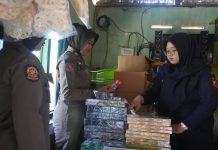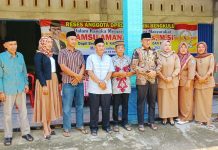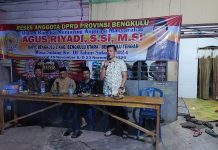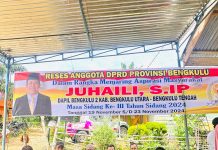The trucks roar along the smuggling routes as if they were highways.
This network of dirt roads zigzagging through thickets of reeds sits just blocks from the main bridge connecting Colombia with its neighbour Venezuela – but it lies far out of the reach of the law.
Houses nearby are tagged with graffiti that rival armed groups use to assert their dominance over key smuggling routes.
Today, sweat-drenched men are slinging plastic packs of Coca-Cola, cleaning products, furniture and food on to the beaten-down trucks before they head into Venezuela.
Other days, the contraband is drugs, migrants or weapons – all part of a criminal underground that has flourished in the years since the historically conservative Colombia severed diplomatic and commercial ties with its socialist neighbour.
A growing number of armed groups have filled that void, and fight a constant and bloody battle for control of this lucrative territory.
For those living here, like Julio Prado, a 23-year-old Venezuelan migrant, every day is a matter of life and death.
“I live in fear every day because I know [the armed groups] could kill me,” said Prado, who makes a living carrying bags along the smuggling routes, known as trochas, or tracks.
Members of the Colombian army patrol the crossing between Colombia and Venezuela before the inauguration of Gustavo Petro. Photograph: Schneyder Mendoza/AFP/Getty Images
A child waits for her father on the Simon Bolivar International Bridge to cross between San Antonio, Venezuela, behind, and Cúcuta, Colombia, on 5 August. Photograph: Matias Delacroix/AP
But this lawless corner of the Andes may see significant changes if Colombia’s new president, Gustavo Petro, makes good on his promise to normalise relations with Venezuela, reduce poverty and achieve “total peace” in a country torn by more than 60 years of armed conflict.
For many border dwellers like Prado, the bold agenda pushed by Colombia’s first ever leftwing president has prompted an unusual measure of hope.
“Families can’t eat, can’t work because the violence has gotten so bad with the border closures,” said Ana Teresa Castillo, a local leader living blocks away from the smuggling routes. “Petro is controversial, many here are scared of him … but this could create jobs, change things.”
After independence from Spain, Venezuela and Colombia were briefly part of the same country and have been tethered by trade, culture and bilateral migration ever since. In recent decades, however, tensions have simmered between the two states – one an outspoken adversary of the US, the other a staunch ally.
Seven years ago, the governments severed commercial ties, cutting off an essential economic lifeline for people on both sides of the 2,200km border.
And in 2019, diplomatic relations were cut when the former Colombian president Iván Duque joined the Trump administration in backing the Venezuelan opposition in a failed attempt to oust President Nicolás Maduro.
Meanwhile, border towns like La Parada have been eclipsed by one of the world’s largest mass migrations: nearly 2.5 million Venezuelan refugees have settled in Colombia alone.
While foot traffic across the frontier is allowed for some permit-holders, some merchants and the most vulnerable migrants have been forced to rely on the criminal underworld to cross – just as the border has become the centre of regional conflict.
Local residents say this sweltering town alone is home to at least 15 mafia groups, including the leftist National Liberation Army (ELN) guerrillas, drug gangs, rightwing paramilitaries and Mexican cartels.
Such groups “control important border regions and profit from the dire situation of migrants and refugees”, said Bram Ebus, an investigator for Crisis Group.
People use the Simon Bolívar International Bridge to cross between San Antonio, Venezuela, top, and Cúcuta, Colombia. Photograph: Matias Delacroix/AP
“Border closures … incentivized armed groups to increase their presence on the border to control and tax contraband networks and human trafficking rings,” Ebus said.
Petro and Maduro have both expressed hopes to change that by normalising trade and diplomatic relations – and in August, the two countries announced ambassadors, a major step in rebuilding the relationship.
If executed, such a shift could ease tensions in the region and, according to Colombia’s commerce minister, Germán Umaña, create $1.2bn in trade this year. By 2026, trade could reach $4.5bn.
Petro, himself a former member of the demobilised M-19 guerrilla, has also taken steps to restart peace talks with ELN rebels. He has pledged to rethink drug policy and reduce poverty, which armed groups exploit to recruit young fighters. (On Tuesday, the Colombian leader also stressed that Bogotá would continue to offer asylum to Venezuelan opposition.)
For migrants like Prado, any improvement on the region’s current lawlessness would be welcome news.
The young Venezuelan has been forced to flee shootouts and has seen bodies dumped by the river he crosses every day. In June, he was threatened with a pistol by ELN guerrillas because they thought he was a member of a rival Venezuelan gang.
“I thought they were going to kill me,” he said.
For Prado, a full reopening of the border offers the hope of a steady, legal job.
“Maybe I’d be able to look for different work, be a little more relaxed because I won’t have to be running for my life or running into danger, I’d just be able to have a stable job,” he said. “I’d be able to pay rent, pay the bills, buy my baby diapers and food.”
Despite such optimism, the two governments have yet to set a date for the reopening, telling anxious business leaders it could happen in months.
A view of a makeshift bridge on the Táchira River that people use to cross through illegal trails in La Parada. Photograph: Matias Delacroix/AP
For Carolina Moros, those months could mean the life or death of her family’s cleaning product business. Since setting up the company five years ago, she has harboured hope that they might be able to trade with Venezuelan customers – an ambition which became more urgent after they lost their biggest domestic client.
“We thought this was going to be a lot faster,” she said. “We [businesses on the border] are the ones that are feeling the urgent need to re-establish this commercial relationship with our neighbouring country.”
But Arlene Tickner, a political science professor at Bogotá’s University of Rosario, warned that dramatic change is hard to achieve in a historically conservative and deeply polarised country like Colombia.
The election of Petro and his vice-president, Francia Márquez, “has potentially overblown expectations as to the degree of change that they’re promising in the country”, she cautioned.
The new president faces significant hurdles to implement his bold agenda, including fiscal turmoil, opposition from the country’s congress, and the spectre of other armed groups waiting in the wings to take over ELN territory if the rebels lay down their weapons, she said.
Meanwhile, many ordinary Colombians like Castillo are watching and waiting with a cautious sense of hope.
“We’re hoping that there will be peace, but we worry we’ll never see it. Here, there’s a war for power, for money, for drugs.”
But, she added: “If they don’t open the border bridges, the people of La Parada will keep dying.”
The post ‘I live in fear’: can Colombia’s new president ease violence at the border? first appeared on Eatory.my.id.
















